Acting For Animation & Character Performance
So. What is acting?
Before I became an animator I had spent many years working in the theatre. It was here, watching performances night after night that I grew to understand that when an actor changes their intonation or a movement from that of a previous performance they can ellicit a completely different reaction from the audience. One night a line or a gesture could get a laugh, the next night the opposite. I was fascinated by this and this for me was a useful starting point as a character animator. I realised that if I wanted to make my characters believable they needed to act, and so I needed to understand how you go about creating the personality and character. In short, understand acting. If I could get the performamce right then my audience would be on board.
But to get there we need to know what the process is…
Lets go through this step by step, from the beginning, which is understanding what acting actually is. Quite simply acting is pretending to be someone or something else. That’s easy. But it is of course more than that. Acting for animation is the art of taking on board the personality and character traits of another and translating them to a previously inanimate object, a cg model, a puppet or a drawing. It is moving these in such a way as to lead your audience to believe that this ‘thing’ can actually think for itself. I believe that acting for animation is distinctly different from live-action acting for film and is closer to performaning on the stage.
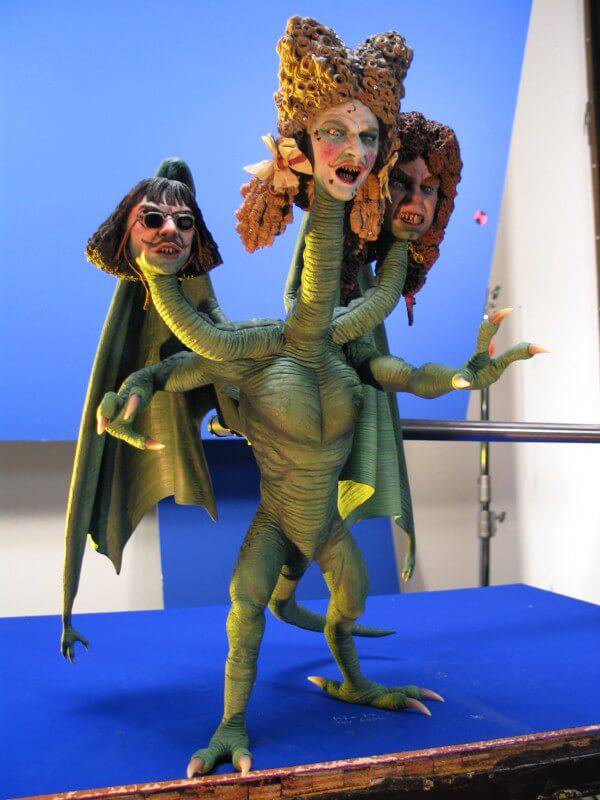
Photo: Andy Joule. Still of the Homunculus from ‘The League of Gentlemen’s Apocalypse’ (Universal/Tiger Aspect/Film Four) This character not only had to act like the three main characters from the League of Gentlemen, but also had to move like a monster. An interesting challenge!
In live action acting movements and gestures can be allowed to be subtle, almost minimal – the slight raising of an eyebrow or shift of focus. When projected, in a cinema these small movements become exaggerated and readable from a distance because a close up on the screen can be many meters high. Acting for the stage differs in that the audience are still placed at a comperable distance from the subject like that of the cinema, but on stage the size of the actor remains constant. In the theatre from the back row of the circle the audience would be hard pushed to read a subtle facial gesture and as far as the actor is concerned they need to compensate the emotions, character and personality through larger gestures, posture and (vocal) intonation to convey the emotional content of the script. Acting for animation shares this similarity with stage acting as animated characters need to make bolder gestures to help convey the self.
It is almost expected that an animated character, by virtue of the fact that it is not ‘real’ can exaggerate movement, or the timing and anticipation of that movement. All animation works with this convention. All forms of animation offer the animator the opportunity to create minutiae of movements, although some are more costly (in terms of time) than others. With stop-motion and drawn animation each thing that moves has to be worked by hand but with CG there is the opportunity to let the software lend a helping hand. This means that you can have a CG character that has movement in every frame, but a stop-motion puppet that moves without a pause seemingly is less believable. A stopmotion puppet should be allowed to rest, or remain motionless from time to time. It is better to let a gesture read, and to hold, than for a character to remain on the move constantly
So, in a nutshell that is acting – just moving about or not moving about, depending on what the script calls for.
Of course it’s not just that! There is so much more to it than these simplistic observations. So what we need to look at and figure out as animators is what is important to understand (about acting and performace) and how then to get this into the character we are working with.
At the end of the day, the reason we are all animators is because we don’t quite have the confidence to get up on that stage and make fools of ourselves. Otherwise we would be doing so, and soaking up the accolades. So instead we do it through our own creations. But, for this to be succesful we need to think and be like an actor, to understand character staging and performance. We are writer, director and performer. Unlike our live-action cousins we need to be able to do all this, and to a very high level.
Over the next few weeks I want to look at a number of key elements that I think are important in understanding how to improve your characer animation. To begin with I want to start with performance…..
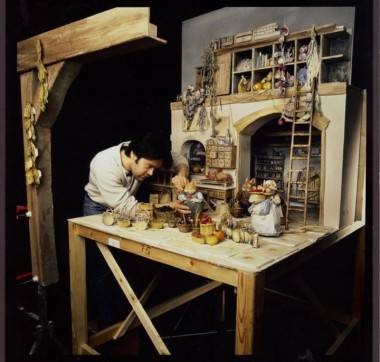
Photo: Courtesy of Paul Couvella. Still from ‘Brambly Hedge (Cosgrove Hall Films/HIT Entertainment). Sometimes an animator has to bring things to life that arent just human. Animating mice, as Paul is doing here draws on years of experience and observation.
Elements of a well animated performance
To my mind performance can be broken into two elements, the vocal performance and the performance of the animation.
Vocal performance
Character animation can rely heavily on the vocal performance of the voice actor. This is driven by three other external factors – the script writer, the actors interpretation of the script (and the directors need to keep a firm hand here) and the directors overall vision. It is the role of the script writer to add personality to the character with words. With this they shape the dialogue and this in turn gives the director an idea of their character. Quite often the director will work with the writer to ensure that this personality sits within the framework of the objectives of the story or stories so that their character remains consistent. If you are starting out writing your own script then you will need to understand the character you are writing for. Think about who they are, what they do, how they react. It might be that your character starts off being a bit like you, so unless you want that, be aware of it – we all speak differently and use different idioms, and we rarely speak in full sentences – just go and eavesdrop on a few conversations and you’ll soon realise how we talk to each other. Flesh out your characters personality, and do your research, try modelling them a mixture of people you know, or characters you’ve seen. But also use your imagination.
With the script finished it is then the role of the director to shape the vocal performance. This will often involve the voice actor being given a back-story (in much the same way that the writer will) as well as an over-view of the events that the character is about to witness or participate in. When I have directed voice artists I needed to give them an idea of what I wanted the animation to do, where I wanted the emphasis, otherwise all the script was were words on a page. This brings the words to life, and shapes the intonation which is the paramount driving force of the animated performance. A flat monotonous delivery can only result in a hunched stilted lifeless performance from the animated character. A lively vocal performance will give rise to an energetic and ‘animated’ character. As an animator you should plan carefully before you start. Work with the voice track and listen to what is said, figure out how the character feels from the tone of the voice as much as from what is said. Often times we will say one thing but mean another, so its important you get this right with your character. Listen out for the ‘key’ moments in the dialogue, moments when there is more emphasis on a part of a word for instance, knowing that this is where your large gesture or move will be. You can then plan from that point back and know when to start the move off so that you hit your ‘marks’.
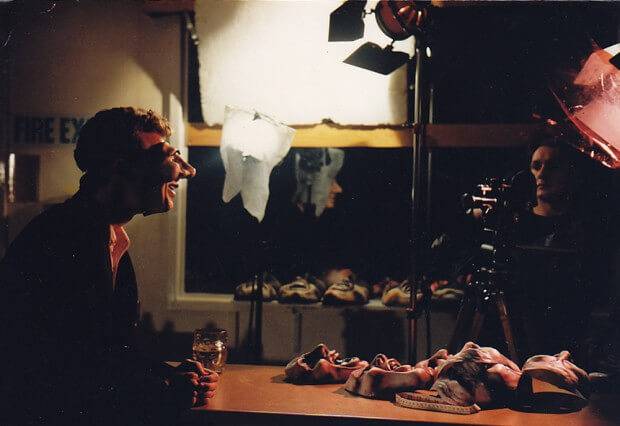
Photo: Courtesy of Darren Walsh. Still from ‘Angry Kid’ (Aardman Animations). The character Angry Kid uses pixillation, and replacement masks and actors. Here Darren is preparing the actor, and briefing him on how to move in relation to the vocal track.
There should always be a dialogue between both the director and animator. The director translate ideas and vision of the performance as they saw it at the storyboard stage and at the voice record into something that the animator understands and can execute. It is here that the director needs to trust in the skills of the animator. The animator is the illusionist possessing the skills that can bring life to the inanimate. The skills of acting are paramount for letting the spectator believe in the performance. A good vocal performance alone is not sufficient at that, and so the animator needs to have a keen grasp of the skills and imagination of an actor.
But, where there is no dialogue you as an animator are on your own. This is your chance as an actor to pick up that Emmy. But the same principles apply – hit the high points of the emtional content of the scene with the most exaggerated movement and accelerate and decelerate out of or in to this point in accordance to what is occuring before and after that ‘moment’. Here is where the old fashioned dope sheet will come in handy.
Don’t dismiss a dope sheet. It can really help you to plan your characters movement, and to ensure that the result is convincing. It should help you to plot your timings (work with a stopwatch to time the movements so that they feel well observed) so you can refer back to them. Break the movements down to key moments in the scene and plan the ‘rise’ and ‘fall’ of those. You don’t have to have many of these in one shot or even in one scene. The important thing for you as an animator (and your dircetor will guide you here too) is to have a rythmical movement to your character within the shot selection prescribed by the director. So don’t go off script!
Performance of the animation
For you as an animator to realise a good performance you need to understand the principals of acting. It’s your role to contribute to the meaning and understanding of a character, and you achieve this through the performance that you give to the character. Empathy is an important strategic skill in achieving this. It is important primarily for animators to understand the personality of the character that they are responsible for, to have rationalised the situation that the character (or quite often set of characters) find themselves in.
The key is taking the understanding of the personality and its inherent character traits, placing them within the situations described by the script and the director and then arriving at a set of empathised actions or reactions shaped by the vocal performance. This will go a long way to delivering something along the lines of a good performance. However the performance of the animation also needs to be interesting and believable. A performance will fall down if we as spectators do not readily accept that the character would behave in that particular way.
In purely practical terms the important thing for any animator to do is to plan the movement of the character to the key moments of the dialogue – as I mentioned earlier. However should the scene be devoid of dialogue then it is down to you as an actor to know how to shape and time movement in order to elicit the responses that you want from your audience. When I animated characters I always enjoyed those scenes where there was no dialogue as it gave me more freedom to get a character to do things as opposed to animating to dialogue where often times you are tied to making the gestures fit with the words.
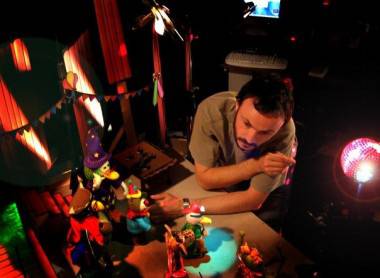
Photo: Christine Vestergaard. Still from ‘Hana’s Helpline’ (Calon). Sometimes as an animator you will be expected to work with a number of puppets, as animator Ben is doing here. The skill is knowing sometimes how little to move something – a really key thing to understand in crowd scenes.
Listen to that voice track again and again, and start to picture yourself (as actor) doing the movements – check the postion of your body, arms, hands, eyes etc. Don’t forget the eyes – these are critical, it’s what we naturally look at first – so be aware of their movement. These tell as much of the story as the words, and in moments of non-dialogue can say more than the body language. A tip is to do the movements yourself, feel your way with it, and to do this a number of times. If you just do it once you wont have really grasped all the movements that your character needs to make. The more you do it the more you can refine the movements as well as becoming more familiar with how all the movements link together. The physicality of the performace is so important. Shrek doesn’t just move, Shrek is Shrek and responds as only Shrek would to whatever confronts him. If you animate Shrek, then be Shrek, think Shrek, move Shrek and eat Shrek! So as an animator you need to think in the same way as your character and when animating you become that character – and this comes down to research
You might find it useful when you first start out animating to video yourself acting the part. You might feel a little self-concious at first, but it’s a good way for you to look at every part of your body to see what its up to, and crucially as an animator, to see how long each movement lasts in frames. It’s also a good idea to have a mirror with you, particularly when it comes to animating facial expressions or lip synching. You can be your best reference point!
I once worked with a director who gave me a character bible for each of the characters that I had to animate, and then sat me down to watch Harold Lloyd, Laurel & Hardy and Chaplin. He wanted me to understand the physicality of their performaces, and to observe the nuances that made them unique. He impressed on me that it was important that all of the characters that I would be animating all had to move in different ways and the character bible helped set out what each of those characters personalities were – one was an eccentric with a touch of the Terry-Thomas about him, another was obsessive and had issues with his stature, or lack of it! So each had to move according to who they were, had a different way of walking, or simply coming through a door, and all of these were timed so each animator knew how long (in frames) each unique character move should be. It also meant it was hard to distinguish the work of any of the team. You will have your own style of performance, and its important to have that, but you also need to be aware of it, and to know whether it’s appropriate or not in a shot. The really critical thing to remember though is to make each characer feel like they are an individual, if not they will be like little extensions of yourself and will all move in remarkably similar ways. Remember to make them perform.
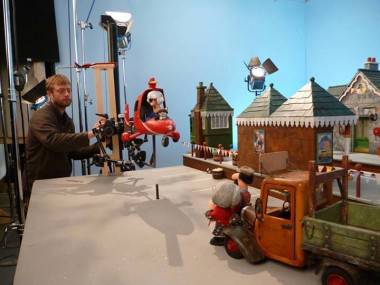
Photo: Bob Skrzynski. Still from ‘Postman Pat (Cosgrove Hall Films). Animation is an illusion, after all without the animator nothing on the set would come to life. A skillful animator will give a character like Postman Pat as much personality as they would his helicopter or van. After all they need to be moved, and given life…
Ultimately all animation is a deciept, a trickery, an illusion. But make that illusion interesting to look at, make it engaging, sympathetic and memorable
In further discussions I will talk about observation, timing, character traits,staging and back history and how by understanding these elements you as an animator could improve your own work.

